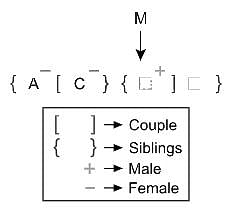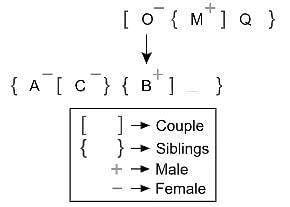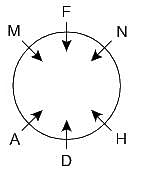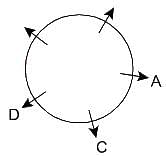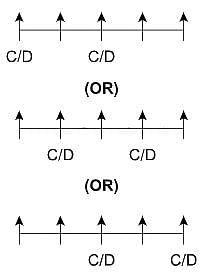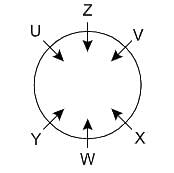MCQ: Data Sufficiency- 1 - SSC CGL MCQ
15 Questions MCQ Test SSC CGL Tier 2 - Study Material, Online Tests, Previous Year - MCQ: Data Sufficiency- 1
Directions: Each of the following consists of a question and two statements numbered I and II given below it. You have to decide whether the data provided in the statements are sufficient to answer the question.
Q. Who is the brother-in-law of A?
I. A is the sister of C, who is the daughter-in-law of M. M has only two children’s.
II. O is the wife of M, who is the sibling of Q. B, is the only male child of O.
II. O is the wife of M, who is the sibling of Q. B, is the only male child of O.
Directions: Each of the following consists of a question and two statements numbered I and II given below it. You have to decide whether the data provided in the statements are sufficient to answer the question.
There are six friends namely K, L, M, N, O and P. Who is the shortest among all?
Statement I: M is shorter than only P. K is taller than both L and N.
Statement II: M is shorter than P and L. K is shorter than P but taller than L. O is shorter than K but not taller than M. P is not tallest.
Statement I: M is shorter than only P. K is taller than both L and N.
Statement II: M is shorter than P and L. K is shorter than P but taller than L. O is shorter than K but not taller than M. P is not tallest.
| 1 Crore+ students have signed up on EduRev. Have you? Download the App |
Directions: Each of the following consists of a question and two statements numbered I and II given below it. You have to decide whether the data provided in the statements are sufficient to answer the question.
Five people namely L, M, N, O and P. Who is the third faster runner among all?
Statement I: O runs faster than N but slower than L. P runs slower than N but is not the slowest runner.
Statement II: M runs slower than N. L runs faster than N and P. O runs faster than only M.
Statement I: O runs faster than N but slower than L. P runs slower than N but is not the slowest runner.
Statement II: M runs slower than N. L runs faster than N and P. O runs faster than only M.
Directions: Each of the following consists of a question and two statements numbered I and II given below it. You have to decide whether the data provided in the statements are sufficient to answer the question.
Six persons are sitting around a circular table and facing the centre. Who sits to the immediate left of N?
Statement I: H sits to the immediate right of D. Two persons sit between D and F. A is an immediate neighbour of M, who sits to the immediate right of F.
Statement II: F and N are immediate neighbours and M sits immediate right of F. A sits third to the left of N.
Directions: Each of the following consists of a question and two statements numbered I and II given below it. You have to decide whether the data provided in the statements are sufficient to answer the question.
A, B, C, D and E are sitting around a circle and facing away from the centre. Who sits second to the right of B?
Statement I: A sits to the immediate left of C. D sits second to the right of A.
Statement II: D sits immediately between E and B. B sits to the immediate left of A.
Directions: Each of the following consists of a question and two statements numbered I and II given below it. You have to decide whether the data provided in the statements are sufficient to answer the question.
Q. What is the rank of A from the top in a class of 23 students?
Statement I: A’s rank is five ranks below H's rank, whose rank is 19th from the bottom.
Statement II: A’s rank is seven ranks above F's rank, whose rank is 11th from the bottom.
Directions: Each of the following consists of a question and two statements numbered I and II given below it. You have to decide whether the data provided in the statements are sufficient to answer the question.
Which statement is required to derive the conclusion - 'No Player is a Champion'?
Statement I: All Stars are Goalkeepers.
Statement II: No Champion is a Player.
Directions: Each of the following consists of a question and two statements numbered I and II given below it. You have to decide whether the data provided in the statements are sufficient to answer the question.
Which statement is required to derive the conclusion – ‘Some cycles are not cars’?
Statement I: All cars are buses. No bus is a train.
Statement II: Some trains are cycles. All cycles are plans.
Directions: Each of the following consists of a question and two statements numbered I and II given below it. You have to decide whether the data provided in the statements are sufficient to answer the question.
Certain words are coded in the following manner in a code language. Find the code for “truck train”?
Statement I: “train of steam” is coded as "126 184 115" and “steam start truck” is coded as "110 126 145".
Statement II: “truck of white” is coded as "113 184 110" and “train of start” is coded as "115 145 184".
Directions: Each of the following consists of a question and two statements numbered I and II given below it. You have to decide whether the data provided in the statements are sufficient to answer the question.
Five people C, D, E, F and G are sitting in a row and facing north. Who among the following sits exactly in the middle of the row?
Statement I: C sits second from the right end of the row and G sits on the immediate left of C.
Statement II: Only one person sits between C and D. E is not an immediate neighbour of G.
Directions: Each of the following consists of a question and two statements numbered I and II given below it. You have to decide whether the data provided in the statements are sufficient to answer the question.
In which month of the year is Kirti’s birthday?
Statement I: Kirti correctly remembers that her birthday is in the second half of the year.
Statement II: Kirti’s father correctly remembers that her birthday is after 31st October but before 1st December.
Directions: Each of the following consists of a question and two statements numbered I and II given below it. You have to decide whether the data provided in the statements are sufficient to answer the question.
Six persons – A, B, C, D, E and F are sitting in a row facing north. Who sits to the immediate left of C?
Statement I: C is the neighbour of A and E, who sits on the extreme right end of the row.
Statement II: C is third to the right of F and second to the left of D.
Directions: Each of the following consists of a question and two statements numbered I and II given below it. You have to decide whether the data provided in the statements are sufficient to answer the question.
Six persons from U to Z are sitting around a circular table and facing towards the centre such that Y is second to the right of Z, who is third to the left of W. Z is on the immediate right of V. Who sits second to the right of U?
Statement I: X is not adjacent to Z.
Statement II: Y is the second to the left of X.
Directions: Each of the following consists of a question and two statements numbered I and II given below it. You have to decide whether the data provided in the statements are sufficient to answer the question.
Find the code for "dove"?
Statement I: 'steady matter ring' is coded as 'tv sf yz' and 'tease right dove' is coded as 'gl oz hv'.
Statement II: 'ring right figure' is coded as 'sf ev oz' and 'steady tease check' is coded as 'gl yz mf'.
Directions: Each of the following consists of a question and two statements numbered I and II given below it. You have to decide whether the data provided in the statements are sufficient to answer the question.
Among five persons – A, B, C, D and E each one of different weight, who is the heaviest?
Statement I: B is heavier than C and D but lighter than E, who is not the heaviest.
Statement II: E is heavier than B and C but lighter than A.
|
1365 videos|1312 docs|1010 tests
|
|
1365 videos|1312 docs|1010 tests
|


